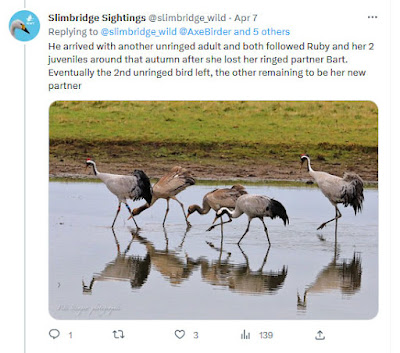On Thursday Joe Stockwell kindly alerted West Dorset/East Devon birders via Twitter that he had seen a Common Crane fly west over Abbotsbury Swannery.
Several hours later Clive texted with news it was on Bridge Marsh! By the time I got there it was circling low over the valley...
 |
| Always an impressive sight! |
And then, in what seemed like just a few seconds, it was a speck! It gained height at speed and disappeared off to the east still gaining height. And then it was gone.
 |
| Very apt at migration despite their cumbersome appearance when on the ground! |
A great bird to see on patch....but was it a wild bird!?
Thankfully I saw Common Crane on the Axe before The Great Crane Project in Somerset had really got going, an adult on Colyford Marsh on 1st April 2012 courtesy of Kev.
For the first few years of The Great Crane Project, even though 93 captive born Common Cranes were released into the wild on the Somerset Levels, they were all sporting obvious colour-rings. So an unringed Common Crane was still fair game, although in my opinion you'd need to see the bird on the ground to be fully sure it was indeed unringed, so from that moment on in my view fly-overs were no longer provable wild.
Fast forward to 2023 and where are we now... Well who knows...
The released and blinged-up GCP Common Cranes started successfully fledging young 'in the wild' from 2015, and since then have fledged 62 chicks. It was thought at the end of 2022 just over 100 GCP Common Cranes were alive and kicking, made up roughly 50/50 of surviving birds from the original introduction (so ringed) and of birds born 'in the wild' (35 of which were unringed!).
Clive saw Thursday's Axe bird well on the deck, and confirmed it was unringed. Was it one of the 35 unringed birds mentioned above, or was it indeed wild!? Well, early spring I would say is the prime time for a wild Crane to turn up in the south coast, especially with an arrival of other overshoots like Hoopoes, Black-winged Stilts and Purple Herons. And this Crane was clearly on the move not wanting to hang around! But does any of that actually mean anything?
Even with all those factors combined, is it not still more likely that one of the unringed 35 has decided to go for a fly around? Presumably the breeding adult GCP birds are getting more territorial so may be forcing younger birds away, and could the blue skies that we've enjoyed this week just be igniting an inner urge for the GCP Cranes to wander? Similar to what the first-summer Red Kites do, sometimes en masse, on warm spring days (also reintroduced!).
You could of course be of the mind set that it doesn't matter at all, it wasn't ringed so wherever it came from it was born in the wild. Whilst that would technically be true, for me reintroduced parents does not make it wild enough.
And then there is another factor that needs to be taken into consideration, possibly a less obvious one...
If the topic wasn't already complicated enough, take a read of this Twitter mini-thread from Slimbridge WWT. I asked them if they knew were their unringed Common Cranes (they currently have eight on site) had come from...
I actually saw 'Ruby' and her unringed wild mate when I visited Slimbridge a month ago with Dad...
 |
| Buy One get (a wild) One Free! |
So basically two wild unringed Common Cranes have joined the GCP Cranes, with one of these birds now breeding with a GCP bird! This begs the question, does having a mostly-resident flock of 100 GCP Common Cranes in the south west actually increase ALL our chances of seeing a wild Common Crane down here? We all see it during our birding, a flock of waders attracts other waders, flocks of gulls attract more gulls, geese flocks attract geese (of any species), same for swans, passerines, etc... The 'pull-factor' of a big flock is unquestionable.
So in conclusion... I am just as unsure and confused as I was before I wrote all this! Will I be adding Common Crane to my Patchwork Challenge 2023 list? I don't think I can. Is that the wrong decision? Maybe. Actually quite probably. I just don't know...
Anyone who wishes to add their opinion, please do...



A dilemma indeed - but what a dilemma. As you say who knows the origin. Protocol has it the UK birds are resident, only moving short hops. Yet some of the GCP birds when first released flew back to Slimbridge - how they got back is a mystery as they were transported down the M5 as juveniles in a trailer before spending months in a very large cage with no adults to learn from (I was there recording it for the BBC). But cranes, as you say, had arrived here anyway before that from the continent. Was your bird an overshoot continental bird, or maybe an East Anglian bird having a wander. Fascinating.
ReplyDeleteIndeed - what a problem to have! Amazing how they found their way back to Slimbridge isn't it, shows it isn't done through any visual clues. Interesting how the Norfolk birds aren't migratory, whereas I believe the rest of the Cranes in Europe are? Does that point to the entire population stemming from introduced captive birds?
Delete